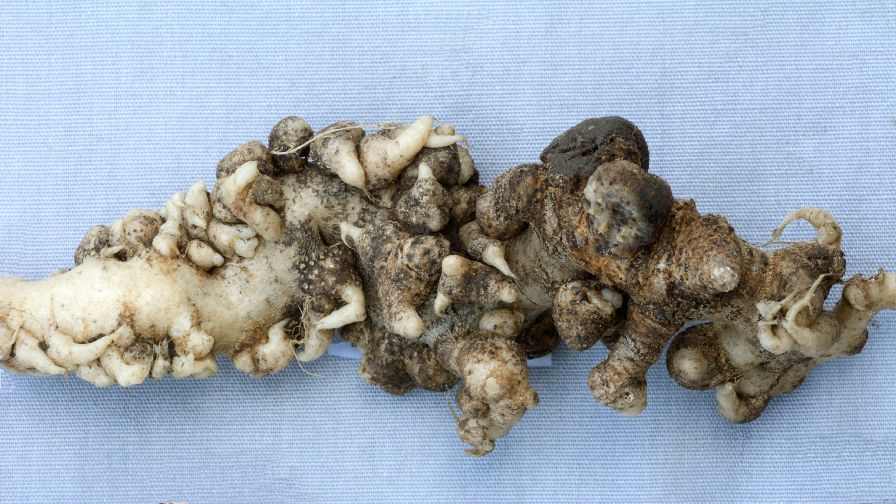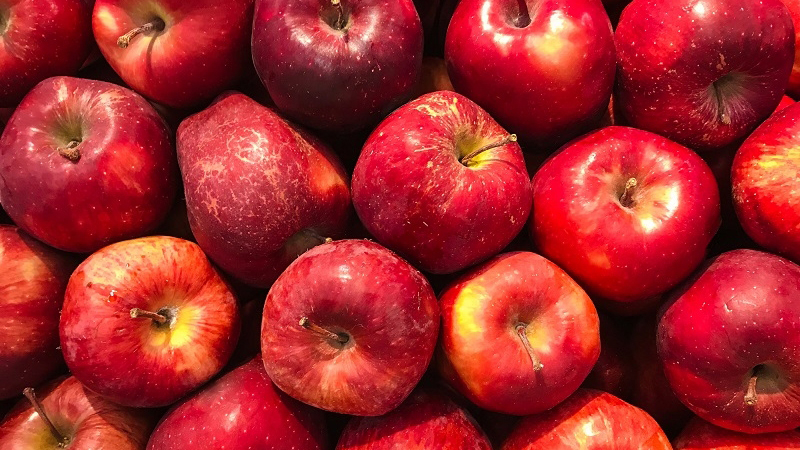Plant Disease Research Can Learn a Lot from Medicine

If soil pH is on the neutral to acidic side, the clubroot pathogen of crucifers flourishes and turns roots, seen here with cabbage, into masses of distorted growths and galls. Photo by Steven T. Koike
Different scientific fields of study can be based upon and share certain common, underlying realities. We can see a good example of shared scientific principles when comparing current medical research on cancer in humans and the strategies to control plant diseases in agriculture.
The majority of cancer research has mostly focused on the cancer cell itself. Tremendous advances have been achieved in our understanding of the cancer cell.
However, given all this knowledge, medical researchers still do not fully understand the dynamics of how cancer spreads within the human body.
Why don’t all cancers metastasize (meaning spread to other places in the body and grow outside of the original disease site) and cause disease throughout the body? Why does a cancer turn aggressive and spread in some patients, but the same type of cancer stays localized and dormant in another person? The need to answer these questions stimulated an additional approach to looking at cancer.
More and more, medical researchers realize that the environment surrounding cancer cells plays a crucial role in what happens in the patient.
Invasion by cancer cells and development of disease are not solely dependent on the cancer cells; instead, the development of disease depends on the interaction and relationship between the cancer cells and the immediate environment of the host cells and tissues.
There are unknown factors in human cells and tissues that restrict metastatic spread and growth of cancer. So not all sites in our bodies are suitable for cancer cells to become active.
To describe this model of cancer development, medical researchers are using the analogy of “seeds” and “soil.” The seeds (cancer cells) will only “take root” and establish themselves if the soil (the local environment made up of host cells and tissues) is suitable for the cancer cells.
Therefore, researchers are increasing efforts to study the “soil” to find out which factors favor cancer cell establishment and which conditions inhibit “germination.” (For more details on this seeds-and-soil approach to medical research, see the article by S. Mukherjee, “The Invasion Equation,” in The New Yorker, Sept. 11, 2017).
Critical Role of Environment in Development of Plant Disease
Experienced farmers and other field professionals know that consideration of the field environment is essential for understanding how diseases of plants get started and develop.
The medical field’s “seeds-and-soil” approach to cancer research is mirrored by agriculture’s “pathogen-and-environment” analysis.
To understand how plant diseases operate for any particular host crop, one must understand the pathogen as well as the environment that both the plant and pathogen share. Almost without exception, a firm understanding of the environment that favors or inhibits plant pathogens will facilitate sounder decisions regarding management of those pathogens.
Environment and Soilborne Pathogens
Soilborne pathogens and the diseases they cause are well understood within the context of the soil environment.
For example, clubroot disease of crucifer crops, caused by Plasmodiophora brassicae, develops under specific soil conditions. If the soil is on the neutral to acidic side, the organism flourishes and can cause significant distortions of the root and subsequent stunting and crop loss.
However, if the soil pH is higher than 7.3, the activity and infectivity of the pathogen are inhibited and clubroot disease will be limited or absent.
Pythium and Phytophthora, the so-called water molds, are likewise best considered with the soil environment in mind. Damping-off diseases affect row crops a number of ways.
Seeds can rot before they can germinate and grow. Seedlings may die before they can emerge above ground, and emergent seedlings may die before they can become established. Pythium is the major pathogen that causes damping-off. Pythium is highly dependent on very wet soils and can become a very aggressive, damaging pathogen under such conditions.
However, under a much drier environment, Pythium usually is less a factor in causing damping-off. Phytophthora causes root and crown rots of many row crops such as asparagus, pepper, tomato, spinach, and strawberry. This water mold also causes disease on specialty herbs such as lavender and sage.
Phytophthora is another soilborne pathogen that is fully operational when the soil environment becomes saturated through prolonged wet weather, over irrigation, or poor drainage of soils. If the soil environment is drier, this pathogen can still be present but likely will be less damaging to the crop.
Environment and Foliar Pathogens
Environment also is an essential consideration for above-ground pathogens and is a key driver for diseases affecting foliage, flowers, and fruit.
Field professionals know that downy mildews of lettuce, spinach, and other row crops are enhanced by cooler, high humidity conditions. Bacterial pathogens are dependent on splashing water from rain and sprinkler irrigation to be spread and enabled to infect plants such as cilantro (bacterial leaf spot caused by Pseudomonas), lettuce (bacterial leaf spot caused by Xanthomonas), pepper (bacterial spot caused by Xanthomonas), tomato (bacterial speck and spot caused by Pseudomonas and Xanthomonas, respectively), and strawberry (angular leaf spot caused by Xanthomonas).
Fungal leaf spot diseases also rely on environmental conditions that include free moisture or high humidity.
Drier weather conditions and the absence of free moisture will inhibit diseases such as celery late blight (caused by Septoria apiicola), parsley Septoria blight (S. petroselini), and fungal blights of carrot (caused by Alternaria and Cercospora). If rain does not fall during the harvest period, strawberry fruit infected with anthracnose (Colletotrichum) will be rare.
Environmental Conditions Key to Management Strategies
Once the important environmental conditions are identified for the various plant pathogens, growers and other field professionals can take steps to alter and modify the environment to minimize damage from pathogens. Field soil pH can be manipulated by adding lime, which will help lessen the impact of clubroot.
Soil preparation can be carried out to enhance water drainage and reduce saturated conditions in fields having a history of water molds; later, careful irrigation management can further lessen disease pressure from water molds. A major advantage in battling foliar pathogens is the use of drip irrigation instead of overhead sprinklers. In the case of celery, for example, the use of drip irrigation has virtually eliminated late blight for many growers.
Steven T. Koike is a plant pathology farm advisor, Monterey County, University of California Cooperative Extension. He can be reached at [email protected].










